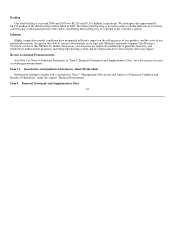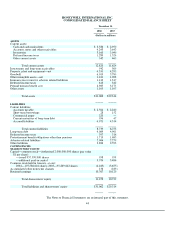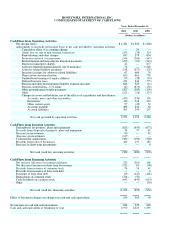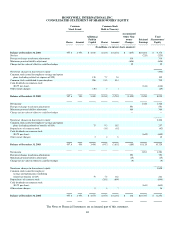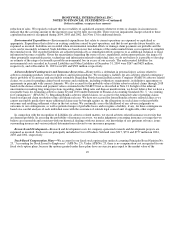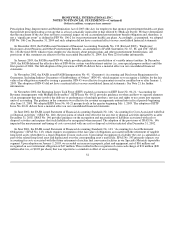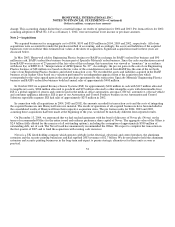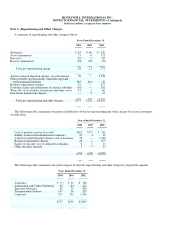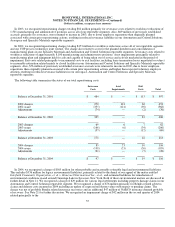Honeywell 2004 Annual Report Download - page 66
Download and view the complete annual report
Please find page 66 of the 2004 Honeywell annual report below. You can navigate through the pages in the report by either clicking on the pages listed below, or by using the keyword search tool below to find specific information within the annual report.
HONEYWELL INTERNATIONAL INC.
NOTES TO FINANCIAL STATEMENTS—(Continued)
(Dollars in millions, except per share amounts)
Long-Lived Assets—We periodically evaluate the recoverability of the carrying amount of long-lived assets (including property,
plant and equipment, and intangible assets with determinable lives) whenever events or changes in circumstances indicate that the
carrying amount of an asset may not be fully recoverable. We evaluate events or changes in circumstances based on a number of
factors including operating results, business plans and forecasts, general and industry trends and, economic projections and anticipated
cash flows. An impairment is assessed when the undiscounted expected future cash flows derived from an asset are less than its
carrying amount. Impairment losses are measured as the amount by which the carrying value of an asset exceeds its fair value and are
recognized in earnings. We also continually evaluate the estimated useful lives of all long-lived assets and periodically revise such
estimates based on current events.
Sales Recognition—Product and service sales are recognized when persuasive evidence of an arrangement exists, product delivery
has occurred or services have been rendered, pricing is fixed or determinable, and collection is reasonably assured. Service sales,
principally representing repair, maintenance and engineering activities in our Aerospace and Automation and Control Solutions
reportable segments, are recognized over the contractual period or as services are rendered. Sales under long-term contracts in the
Aerospace and Automation and Control Solutions reportable segments are recorded on a percentage-of-completion method measured
on the cost-to-cost basis for engineering-type contracts and the units-of-delivery basis for production-type contracts. Provisions for
anticipated losses on long-term contracts are recorded in full when such losses become evident. Revenues from contracts with multiple
element arrangements are recognized as each element is earned based on the relative fair value of each element and when the
delivered elements have value to customers on a standalone basis. Amounts allocated to each element are based on its objectively
determined fair value, such as the sales price for the product or service when it is sold separately or competitor prices for similar
products or services.
Aerospace Customer Incentives—We provide sales incentives to commercial aircraft manufacturers and airlines in connection
with their selection of our aircraft wheel and braking system hardware and auxiliary power units for installation on commercial
aircraft. These incentives consist of free or deeply discounted products, product credits and upfront cash payments. The cost of these
incentives are capitalized at the time we deliver the products to our customers or, in the case of product credits, at the time the credit is
issued, or in the case of upfront cash payments, at the time the payment is made. In the case of free or deeply discounted product, the
cost to manufacture less any amount recovered from the airframe manufacturer or airline is capitalized. Product credits and upfront
cash payments are capitalized at exchanged value. Research, design, development and qualification costs related to these products are
expensed as incurred, unless contractually guaranteed of reimbursement. The cost of the sales incentives described above is
capitalized because the selection of our aircraft wheel and braking system hardware and auxiliary power units for installation on
commercial aircraft results in the creation of future revenues and cash flows through aftermarket sales to fulfill long-term product
maintenance requirements mandated by the Federal Aviation Administration (FAA) and other similar international organizations over
the useful life of the aircraft. Once our products are certified and selected on an aircraft, the recovery of our investment is virtually
guaranteed over the useful life of the aircraft. The likelihood of displacement by an alternative supplier is remote due to contractual
sole-sourcing, the high cost to alternative suppliers and aircraft operators of product retrofits, and/or rigorous regulatory specifications,
qualification and testing requirements. We amortize the cost of these capitalized sales incentives over their useful lives on a straight-
line basis, up to 25 years, representing the estimated minimum service life of the aircraft. This useful life is the period over which we
are virtually assured to earn revenues from the aftermarket sales of certified products necessary to fulfill the maintenance required by
the FAA and other similar international organizations. We classify the amortization expense associated with free and discounted
products as cost of goods sold and the amortization expense associated with product credits and upfront cash payments as a
48



